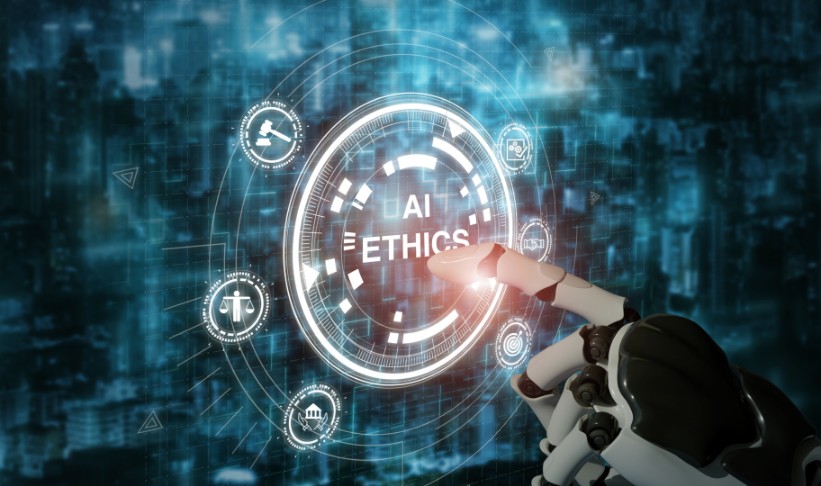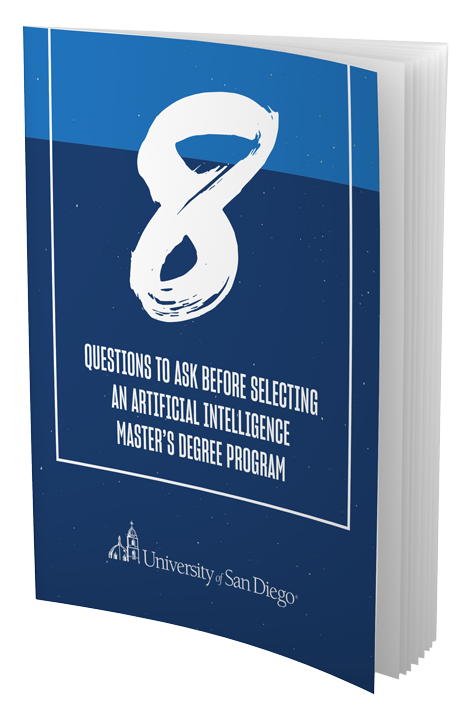Artificial intelligence (AI) is rapidly transforming a wide range of industries, from healthcare to finance, while creating opportunities for efficiency, automation and innovation. As AI becomes more widespread, certain challenges highlight the urgent need to address the ethics of AI and develop robust frameworks to guide responsible implementation.
Adopting ethical AI frameworks is crucial for mitigating risks and ensuring that AI technologies are used responsibly. In this post, we’ll explore key artificial intelligence ethical issues, discuss principles guiding ethics in artificial intelligence and share strategies for implementing ethical AI in organizations.
What Are AI Ethics?
AI ethics refers to the set of moral principles and guidelines that govern the development and use of artificial intelligence technologies.
Key components of AI ethics include:
- Avoiding bias by ensuring AI systems don’t perpetuate societal biases, achieved through careful training and data selection.
- Ensuring privacy and data protection by safeguarding personal data and preventing misuse by prioritizing security and privacy.
- Mitigating environmental impact, i.e. reducing the carbon footprint of AI systems, by optimizing energy usage and considering ecological consequences. In essence, ethics in artificial intelligence balances innovation with responsibility, ensuring AI benefits society without adverse side effects. By adhering to these principles, organizations can build AI systems that are trustworthy, fair and aligned with human values.
- Respect for persons: Ensuring individuals have control over how their data is used, with the right to informed consent and the ability to opt out of AI systems, especially when dealing with sensitive information.
- Beneficence: Prioritizing “do no harm” by minimizing risks such as biased decision-making and ensuring AI enhances positive outcomes without amplifying societal harms.
- Justice: Promoting fairness by ensuring AI benefits and burdens are shared equitably, without disadvantaging any group based on factors like race, gender, or socioeconomic status. Additionally, the Menlo Report, published in 2012, extends the Belmont principles to information and communication (ICT) research, emphasizing the ethical responsibilities of those designing systems with the inclusion of the fourth principle:
- Respect for law and public interest: Engaging in legal due diligence; being transparent in methods and results and accountable for actions.
Establishing Principles for AI Ethics
To create ethical AI frameworks, organizations can look to foundational ethics principles such as those outlined in the Belmont Report, which was originally developed to protect human subjects in research. Over time, the academic community has adapted these principles to guide ethical practices in experimental research and the development of AI algorithms.
Key principles include:
- Respect for persons: Ensuring individuals have control over how their data is used, with the right to informed consent and the ability to opt out of AI systems, especially when dealing with sensitive information.
- Beneficence: Prioritizing “do no harm” by minimizing risks such as biased decision-making and ensuring AI enhances positive outcomes without amplifying societal harms.
- Justice: Promoting fairness by ensuring AI benefits and burdens are shared equitably, without disadvantaging any group based on factors like race, gender, or socioeconomic status.
Additionally, the Menlo Report, published in 2012, extends the Belmont principles to information and communication (ICT) research, emphasizing the ethical responsibilities of those designing systems with the inclusion of the fourth principle:
- Respect for law and public interest: Engaging in legal due diligence; being transparent in methods and results and accountable for actions.
Top 4 Ethics of AI Concerns
As AI technologies continue to evolve, several pressing ethical concerns have emerged. These issues often stem from the increasing complexity of AI systems, the vast amounts of data they process and their growing impact on society.
1. Foundation Models and Generative AI
Large-scale AI models, such as those used in generative AI, raise ethical questions about bias, transparency and accountability. These models, trained on massive datasets, can unintentionally reinforce harmful biases or generate misleading information. Furthermore, their “black box” nature makes it difficult to explain how decisions are made, causing concerns about transparency.
2. Technological Singularity
Although the concept of AI surpassing human intelligence (also known as the technological singularity) is largely theoretical, it presents significant ethical considerations. If AI systems were to operate beyond human control, the implications for decision-making, autonomy and accountability would be profound. This leads to questions about how much control humans should maintain over AI.
3. Impact on Jobs
AI’s ability to automate tasks and make data-driven decisions is transforming industries, but it also presents ethical dilemmas related to job displacement. Balancing technological progress with societal responsibility requires assurance that workers are supported through reskilling and job transition programs.
4. Privacy
The reliance of AI on vast amounts of personal data poses serious privacy concerns. Ethical AI frameworks must prioritize protecting user data from unauthorized access while ensuring transparency in how that data is collected, stored and used.
Tackling these concerns requires collaboration among policymakers, developers and organizations to ensure AI technologies remain innovative and ethically sound.
Theory vs. Practice in AI Ethics
While these ethical concerns are widely recognized, the challenge lies in translating these principles into day-to-day practice. According to a report from Stanford University’s Human-Centered Artificial Intelligence (HAI) initiative, many organizations “talk the talk” of AI ethics without fully integrating these principles into their operations. While ethical guidelines are created, the challenge lies in translating them into actionable and sustainable policies.
One key challenge is operationalizing ethical principles. For example, while the principle of fairness might dictate that an AI system should avoid bias, fairness is subjective and varies across cultural, legal and societal contests. Ensuring fairness in practice requires organizations to engage with diverse stakeholders, take specific and measurable steps. This might involve regularly auditing algorithms for bias, selecting diverse training datasets and ensuring that diverse teams are involved in the AI development process.
Another challenge is the pressure for rapid deployment. In fast-paced industries where innovation drives competition, ethical considerations can sometimes be overlooked in favor of launching new AI systems quickly. This tension between speed and ethics can lead to AI systems that aren’t thoroughly vetted for fairness, accountability or transparency, potentially resulting in negative societal impacts.
Additionally, organizational culture can impact the consistent application of AI ethics. Teams with varying priorities — such as technical development versus business goals — might interpret or prioritize ethical principles differently.
Ultimately, bridging the gap between theory and practice requires strong leadership, clear accountability structures and ongoing monitoring. Organizations must commit to embedding ethics into every stage of the AI development lifecycle, from ideation to deployment and ensure that ethical standards are maintained even under the pressures of innovation and competition.
The Role of Regulations in AI Ethics
While internal ethical frameworks are essential for guiding AI development, external regulations play a crucial role in ensuring that AI systems adhere to universal standards of fairness, transparency and accountability. Some governments and international organizations have recognized the growing ethical concerns surrounding AI and have begun establishing regulatory frameworks to guide responsible AI use.
GDPR (General Data Protection Regulation)
Introduced by the European Union, GDPR sets strict guidelines on how personal data should be collected, processed and stored. For AI systems, this means that organizations must ensure transparency in how they handle user data, provide mechanisms for users to opt out and protect against unauthorized access. GDPR also introduces the “right to explanation,” which demands transparency in AI-driven decisions.
EU AI Act
The EU’s AI Act is the world’s first comprehensive AI regulation. It establishes a risk-based framework for AI applications categorizing them into unacceptable, high-risk, limited-risk and minimal risk systems. Systems that fall under unacceptable-risk such as social scoring, manipulative AI and biometric categorization that discriminate are outright banned under the AI Act. High-risk applications such as those used in healthcare and hiring settings must meet strict requirements for human oversight, transparency and risk mitigation.
The Organization for Economic Cooperation and Development (OECD)
OECD has developed guidelines to promote trustworthy AI. These principles emphasize fairness, transparency and the protection of human rights. Governments and companies are urged to ensure AI systems are designed to benefit people and avoid causing harm.
The Changing Landscape of AI Regulation in the U.S.
Under President Biden’s administration, the federal government made efforts to establish guardrails for AI development, issuing an Executive Order on Safe, Secure, and Trustworthy Development and Use of Artificial Intelligence. This initiative aimed to protect civil rights, improve transparency and ensure accountability in AI-driven decisions that impact jobs, loans, law enforcement and more.
However, the new Trump administration is reversing course. In the early weeks of his presidency, President Trump repealed Biden’s AI Executive Order and removed federal AI guidelines from official government websites, signaling a rollback of ethical safeguards. The administration has also directed agencies to revise their AI policies, emphasizing rapid deployment over oversight. This change culminated with Trump’s Executive Order Removing Barriers to American Leadership in Artificial Intelligence.
This deregulation raises significant concerns about the unchecked expansion of AI, especially in areas affecting employment, financial access and government services. Without proper regulatory safeguards, the risk of AI-driven discrimination, privacy violations and inaccurate decision-making increases — potentially resulting in tangible consequences.
As the U.S. government shifts its stance on AI oversight, organizations must take proactive steps to establish and uphold their own ethical AI policies. Remaining compliant with global standards like GDPR and OECD principles, while also conducting independent audits and risk assessments, will be essential for maintaining trust and accountability in AI deployment.
Implementing Ethical AI Frameworks in Organizations
Establishing ethical AI frameworks within organizations requires a proactive and structured approach to ensure that certain principles are integrated throughout the AI development lifecycle. From the initial design phase to post-deployment monitoring, organizations must embed ethical considerations into every step of the process.
Here’s a closer look at four strategies for implementing ethical AI frameworks.
1. Developing Internal Ethical Guidelines
Organizations should create clear internal policies outlining their approach to AI ethics. These guidelines should cover areas such as data privacy, bias prevention and accountability. Establishing an AI Ethics Committee or task force can help ensure these guidelines are enforced and updated regularly based on evolving ethical standards and regulations.
Related Resource: Learn more about the role of an AI ethicist and how they guide organizations through complex ethical considerations >>
2. Training and Awareness Programs
It is critical to educate employees — especially those involved in AI development — on ethical AI practices. Embedding ethics into AI development empowers teams to make informed decisions that align with the organization’s ethical commitments.
3. Integrating Ethics into the AI Development Process
Ethical considerations should be part of the AI design process from the beginning. This includes choosing various, representative datasets, conducting regular bias audits and ensuring transparency in algorithmic decision-making. Regular testing and refining of AI models based on these principles can help mitigate ethical risks early.
4. Monitoring and Continuous Improvement
Ethical AI requires ongoing oversight to ensure compliance. Organizations should regularly audit AI systems for fairness, transparency and accountability. Organizations can also use third-party audits to ensure objectivity.
Real-World Examples of Ethical AI Implementation
Several well-known organizations have made significant strides in adopting ethical AI frameworks. These real-world examples illustrate how companies can successfully navigate the challenges of implementing ethical principles in AI development and deployment.
IBM’s AI Ethics Board
IBM has established an internal AI Ethics Board to guide the development of its AI technologies. The board is responsible for ensuring that IBM’s AI systems are designed and deployed in accordance with its Principles of Trust and Transparency, which prioritize fairness, accountability and privacy. By embedding ethical considerations into every stage of its AI development, IBM has positioned itself as a leader in trustworthy AI.
Google’s AI Fairness Initiative
Google has committed to reducing bias in its AI systems through its Responsible AI Practices initiative. Google’s AI principles prohibit the use of AI for harmful purposes, such as surveillance or violations of human rights, demonstrating the company’s commitment to ethical AI.
Microsoft’s Responsible AI Standard
Microsoft has developed a comprehensive Responsible AI Standard that governs its approach to ethical AI development. This framework includes six key principles: fairness, reliability and safety, inclusiveness, privacy, transparency and accountability. Microsoft has implemented internal ethics reviews for all AI projects and has trained thousands of employees in ethical AI development to ensure these principles are applied consistently.
Deloitte’s AI Risk Management Framework
Deloitte offers an AI Risk Management Framework to help organizations assess and mitigate the ethical risks associated with AI. Deloitte helps its clients integrate ethical AI practices into business operations, ensuring that AI systems align with regulatory standards and ethical guidelines.
Organizations that Promote AI Ethics
Several global organizations are actively promoting AI ethics to ensure AI technologies are developed responsibly and used for the betterment of society. These include:
- AlgorithmWatch: A non-profit organization that focuses on transparency in automated decision-making systems
- AI Now Institute: Based within New York University, this institute researches the social implications of AI, focusing on issues such as bias, inequality and accountability
- DARPA: The Defense Advanced Research Projects Agency promotes research into explainable AI (XAI) to make complex AI models more transparent and understandable, particularly in defense applications
- Partnership on AI: A coalition of leading technology companies and academic institutions, working together to share best practices and establish ethical standards in AI development
The Path Forward: Ethics and AI
As AI integrates into everyday life, organizations must implement robust ethical frameworks that prioritize fairness, accountability and transparency. Doing so not only mitigates risks but also builds trust with users and stakeholders.
Building a career in AI requires mastering both technical skills and ethical considerations. Learn more about how to choose the right master’s program to develop this necessary skill set with our eBook, 8 Questions to Ask Before Selecting an Applied Artificial Intelligence Master’s Program.





